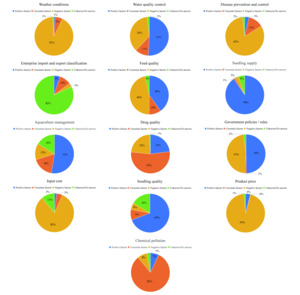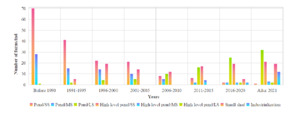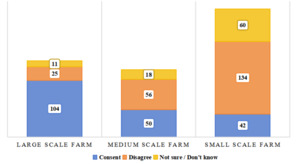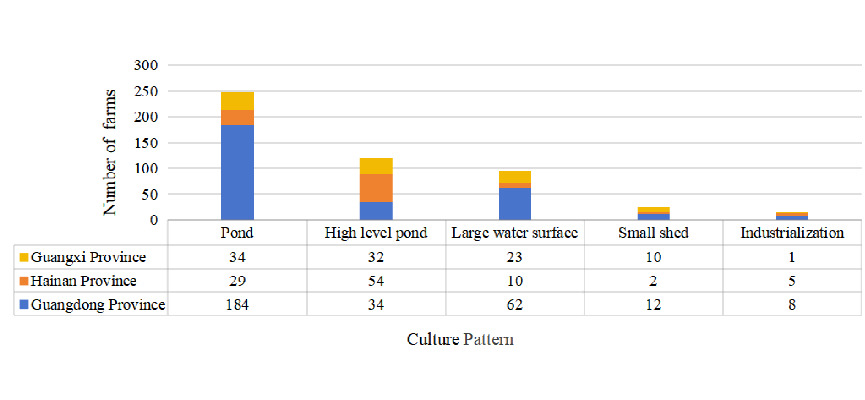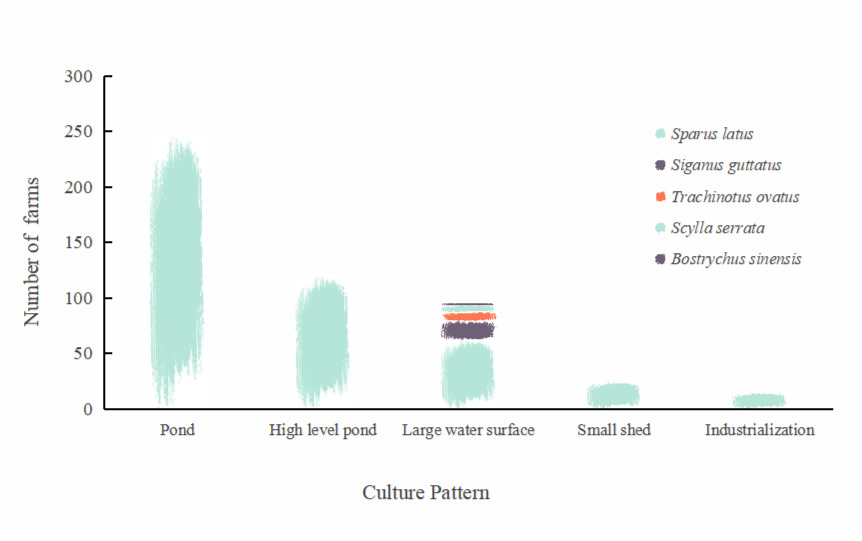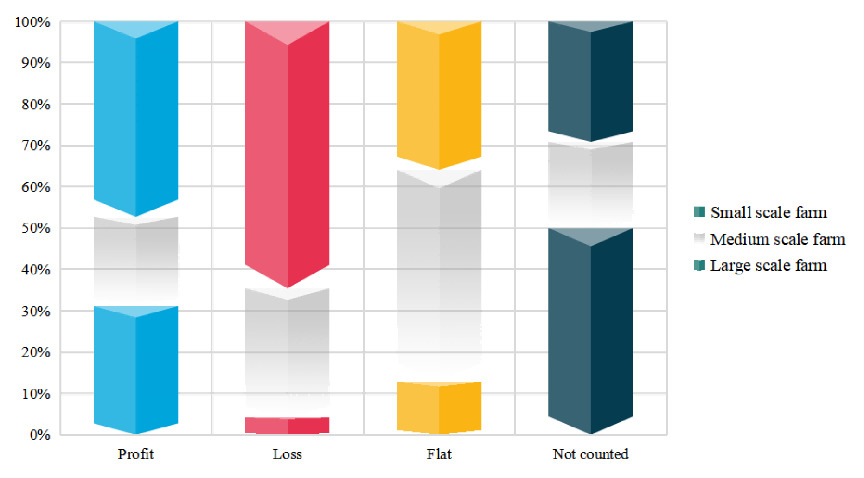Introduction
Production of crustaceans culture in China reached 2055 tons in 2023 and of that, 85.95% was contributed by shrimp species.1 Of all penaeids, the black tiger shrimp Penaeus monodon is among the largest penaeid species and the second most produced penaeids species after white leg shrimp Litopenaeus vannamei, with almost 81.12% being cultured in Guangdong Province, Guangxi Province, Hainan Province, the three provinces of South China.1 So that the culture and intensive production of P. monodon support not only the livelihood of coastal communities but also the economic growth of many aqua-farmers.2,3 At a point in shrimp farming, P. monodon was the most widely farmed species in South China due to its rapid growth rate,high market value and potential for larger size attainment than other species that were mostly cultured.4–6 However, the occurrence and prevalence of diseases such as white spot syndrome(WSSV) and vibriosis in P. monodon farms and the introduction of L. vannamei to China have led to the shift from P. monodon to L.vannamei among shrimp farmers.7–10 In order to explore the current situation of P. monodon farming and the existing problems, as well as the sustainability of farming, we conducted this study to introduce the P. monodon industry in South China Provinces briefly, and provide some reference for the worldwide P. monodon aquaculture industry and the policy-making of relevant government departments.
Materials and Methods
Materials
Relevant statistical data were sorted, literature and reports were consulted. A structured questionnaire was designed to collect data on farming practices, economic performance, and sustainability perceptions. The survey targeted 500 shrimp farms across 20 main production areas in Guangdong, Guangxi, and Hainan provinces, selected through stratified random sampling to ensure representation of small-, medium-, and large-scale operations (sample size determined by Cochran’s formula with a 95% confidence level and 5% margin of error) Ethical approval was obtained from the South China Sea Fisheries Research Institute Ethics Committee, and informed consent was secured from all participants.
Methods
Using multiple stratified and random sampling, status of system workshop, Google Earth random partitioning, SPSS and Excel software were used for data statistics.
Results
Distribution of Aquaculture Models in the Three Provinces
Survey results reveal five primary aquaculture models for P. monodon in the three provinces of South China: Pond, High-level pond, Large water surface, Small shed, and Industrialized farming (Figure 1). Among these, Pond aquaculture dominates with a share of 49.40%, followed by High-level pond at 24.00%. Notably, the proportion of industrialized farming in Hainan Province (5.00%) exceeds that of Guangdong Province (2.67%) and Guangxi Province (1.00%).
Aquaculture Species Across Different Farming Models in the Three Provinces
Survey results indicate that among the P. monodon aquaculture models in the three provinces of South China, Pond, High-level pond, Small shed, and Industrialized farming models are exclusively monocultures of P. monodon. In contrast, the Large water surface model involves polyculture with other economically valuable species. Specifically, yellowfin seabream (Sparus latus) and rabbitfish (Siganus spp.) dominate the polyculture system, accounting for 65.26% and 17.89% of the total, respectively (Figure 2).
Operational Status of P. monodon Aquaculture Enterprises/Farms in 2023
In 2023, 77.80% of surveyed P. monodon aquaculture enterprises/farms were profitable. Among small-scale farms, 77.97% achieved profitability, accounting for 36.80% of all profitable farms. However, small-scale farms also represented a high proportion (64.58% ) of loss-making farms. In contrast, only 1.43% of large-scale farms incurred losses, likely due to factors such as excessively high stocking densities and relatively higher farming risks in small-scale operations (Figure 3).
Sustainability Factors in P. monodon Aquaculture
We surveyed aquaculture farmers to identify factors influencing the sustainable development of P. monodon farming, with respondents quantitatively ranking the proposed indicators. Results showed that seedling supply, seedling quality, aquaculture management, water quality control, and government policies/regulations were regarded as the top positive drivers for sustainable development. These findings align with the subsequent discussion on seed fraud and policy gaps, highlighting the need for centralized quality control. A minority of respondents identified factors such as enterprise import-export grading and input costs as uncertain elements. The most highly ranked negative factors included product pricing, weather conditions, input costs, and disease control (Figure 4).
Trends in Development of Aquaculture Enterprises with Different Scales and Farming Models
The investigation results reveal that the development of P. monodon aquaculture has exhibited a relatively stable growth trend. Between 1991 and 2020, newly established aquaculture enterprises ranged from 35 to 63 per five-year interval. The small-scale High-level pond culture model primarily expanded between 1996 and 2020, while enterprises adopting Small shed culture systems and industrialized farming models only gradually emerged after 2016. This progression aligns with the broader shift toward precision farming, automated systems, and sustainable practices observed in modern aquaculture development (Figure 5).
Parental Attitudes Toward Offspring Engaging in P. monodon Aquaculture
The survey reveals that across all farm scales, 43.00% of respondents expressed unwillingness to encourage their offspring to pursue careers in P. monodon aquaculture. This sentiment was unevenly distributed among farm sizes: 26.80% of respondents from small-scale farms held this view, compared to 11.20% in medium-scale and 5.00% in large-scale operations. The primary reason cited was the perception of the industry as overly labor-intensive and technically undemanding, which aligns with broader concerns about occupational sustainability and skill development in aquaculture. Notably, this indicates that nearly half of the respondents in the three southern provinces of China hold negative perceptions regarding the sustainable development prospects of the P. monodon aquaculture sector (Figure 6).
Discussion
Based on the survey findings and identified challenges in P. monodon aquaculture across three provinces of South China, this study employs a comprehensive set of indicators spanning economic, environmental, and social dimensions to systematically evaluate the sustainability of shrimp farming practices in the region.
Economic Drivers and Trade-offs
Profitability Trends and Industrialization
The three South China provinces possess a coastline spanning 7,552.74 km, accounting for 23.60% of China’s total coastal length.1 Their expansive shallow tidal flats, abundant harbors, and unique geographical advantages have fostered a thriving P. monodon aquaculture industry.11 As a high-value commodity in international aquatic trade, P. monodon has emerged as a flagship cultivated species, establishing a comprehensive industrial chain with an annual output value of 80 billion CNY. This sector generates 500,000 direct employment opportunities and supports over 2 million livelihoods.1 The region leads nationally in seven key metrics: aquaculture area, postlarval production, shrimp yield, feed output, processing capacity, export volume, and the operation of China’s largest specialized shrimp trading market.1
Small shed and Industrialized farming aquaculture systems have gained prominence in Guangdong and Hainan provinces. Characterized by standardized infrastructure and mechanized operations, these systems integrate seawater disinfection technologies and modern bio-based water purification methods, effectively curbing pathogen transmission. This innovation has significantly enhanced P. monodon survival rates and yield, driving transformative upgrades in sustainable shrimp farming practices.12
Cost Pressures and Market Dynamics
From the perspective of domestic and international markets, production costs-including pond rentals, feed, and pharmaceuticals-are rising. In Zhanjiang, Guangdong Province, some small-scale farms have shifted to high-density, high-input, and high-pollution P. monodon aquaculture practices to accelerate cost recovery, thereby constraining sustainable development. The Waste water treatment cost increase makes the transformation window period of sustainable technologies such as circulating water system rapidly narrow, and the sustainable development of the industry is facing a critical point challenge.
According to reports, the periodic sedimentation rate of shrimp pond substrates has reached nearly 200 t ha-¹.13 Sediments discharged from shrimp farms into adjacent environments after harvest can cause globally significant environmental impacts.14 Studies have demonstrated that polyculture of Penaeus chinensis with Perinereis aibuhitensis or Crassostrea gigas can reduce pollutants in pond substrates and effectively improve shrimp survival rates.15 Oyster filter-feeding has been shown to decrease bacterial concentrations in water bodies, mitigate pollutant levels in shrimp ponds, and reduce eutrophication.16 Consequently, the high-level pond aquaculture model requires further standardization and innovation. For example, integrating bivalve cultivation and optimizing facility layouts within farming zones to achieve regulated water intake and drainage systems. This approach aims to establish a novel aquaculture model characterized by ecological stability, resource efficiency, environmental compatibility, and resilience to external risks.
Environmental Challenges and Innovations
Current Situation of Environmental Pollution
The rapid expansion of high-density, large-scale P. monodon aquaculture has led to the overloading of coastal waters, resulting in a progressive decline in disease resistance and frequent disease outbreaks among cultured shrimp.17 In our investigation, it was observed that currently, coupled with the aging of high-level ponds and the discharge of untreated wastewater from P. monodon aquaculture by small-scale farmers with poor environmental awareness directly into the sea. In recent years, some farms even releasing wastewater directly into ponds, the coastal waters have experienced increasing eutrophication, accompanied by the accumulation of sediments and pathogens.
Regulatory in Chemical Use
Indiscriminate use of antibiotics and other chemicals in some aquaculture facilities has disrupted microbial ecosystem balance, promoting the emergence of antibiotic-resistant pathogens. Additionally, antibiotic residues accumulated in shrimp tissues pose significant risks to export quality and food safety.18 Microbial agents are gaining increasing favor among aquaculture facilities, and their widespread application has become a trend toward ecological and sustainable P. monodon farming.19–22 Our survey revealed that some feed manufacturers provide phototrophic bacteria free of charge at a fixed ratio when supplying feed to farms. Although farmers’ environmental awareness is gradually improving, the use of probiotics remains sporadic—often applied only when farmers recall or when shrimp exhibit abnormalities—leading to expired or ineffective microbial agents due to unplanned usage. This highlights the necessity for targeted training and technical guidance to enhance farmers’ participation in standardized aquaculture practices and resource optimization.
Social Perceptions and Labor Dynamics
Policy Interventions for Development
The fragmented household contract system, characterized by small-scale operations, low industrialization levels, limited technological integration, poor market responsiveness, and weak risk resilience, demonstrates significant misalignment with modern economic demands.To address these challenges, the P. monodon industry should undergo consolidation and restructuring to establish large-scale, efficient enterprises with robust market expansion capabilities, including vertically integrated operations spanning production, supply, and marketing. Simultaneously, optimizing human resource allocation and enforcing strict quality control in water intake, seed procurement, and farming practices are critical. Strategic alliances across upstream and downstream sectors could further foster market-oriented production systems aligned with global and domestic demand.
With the promotion of domestically bred shrimp varieties, seed quality has significantly improved, and the domestic supply of new seed strains now meets market demands. However, some companies have been reported selling second-generation shrimp larvae as first-generation products, exploiting farmers’ limited capacity to distinguish between them. This issue stems from high-profit margins in seed production, low technical barriers, and inconsistent technician qualifications. To address this, provincial governments should establish a mandatory seed certification program, enforced through third-party audits and blockchain traceability systems. Collaboration between feed companies and research institutions could standardize probiotic application protocols, while subsidies for automated water treatment systems would reduce small-scale farmers’ reliance on antibiotics. Additionally, increased investment in broodstock and seed technology alongside the establishment of commercial seed brands could reduce reliance on imported or wild caught broodstock, thereby securing greater autonomy in P. monodon aquaculture.
Intergenerational Workforce Attitudes
Nearly half of the respondents expressed negative attitudes toward encouraging their children to engage in P. monodon aquaculture. To address this, governments should intensify promotional efforts to disseminate the principles of ecological and sustainable aquaculture models and highlight the industry’s future prospects. Strengthening supportive policies, such as stabilizing shrimp prices and implementing measures to secure farmers’ confidence in the sector which is also critical to fostering intergenerational continuity in the industry.
Acknowledgments
This study was supported by Central Public-interest Scientific Institution Basal Research Fund, South China Sea Fisheries Research Institute, CAFS (NO.2024RC03), the earmarked fund for CARS-48, Central Public-interest Scientific Institution Basal Research Fund, CAFS (NO.2023TD34), the earmarked fund for HNARS(HNARS-10-ZJ01), Innovative Team Building Project of Guangdong Modern Agricultural Industrial Technology System (2024CXTD25), Zhanjiang Science and Technology Program Project (2023A01015).
Data Availability statement
The data that support the findings of this study are available on request from the corresponding author.
Conflict of interest
The authors declare that there is no conflict of interests.
Authors’ Contribution
ZWS, YCC, JCM and SJ designed the study. QYX, JZS and JYW took part in the execution of study. SJ, and FLZ implemented the study and involved in sampling as well as testing. ZWS, YCC and JCM drafted the manuscript. All the authors read and accepted the final manuscript before submission.
Ethical Approval
The whole experiment was conducted according to the guidelines established by the National Institutes of Health.




